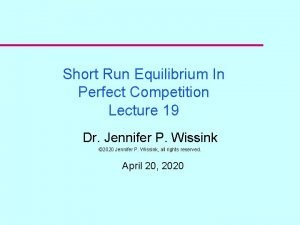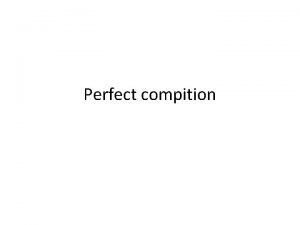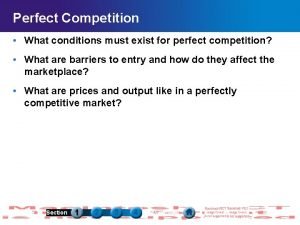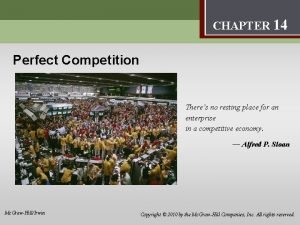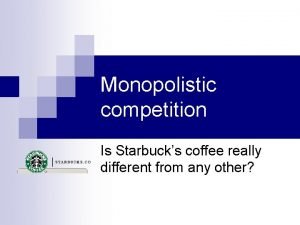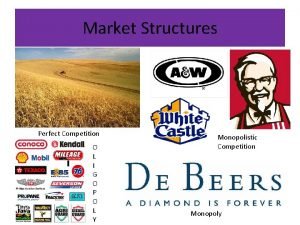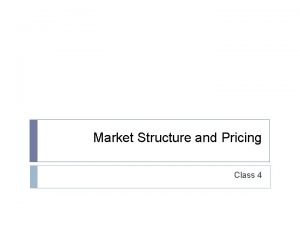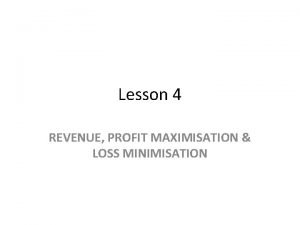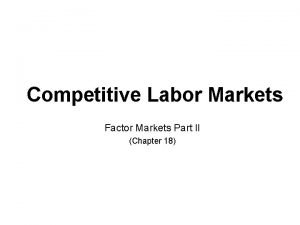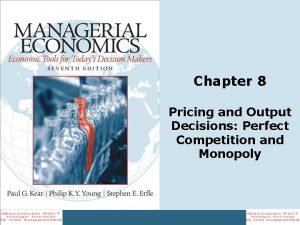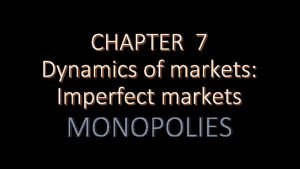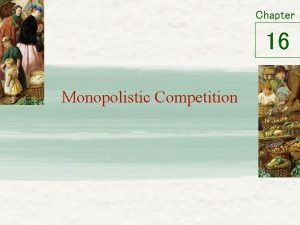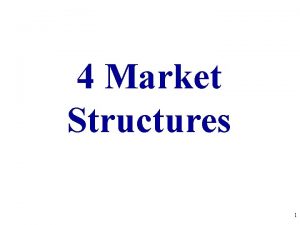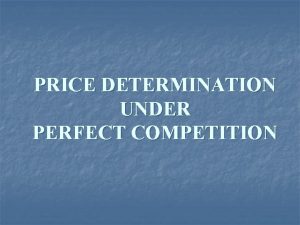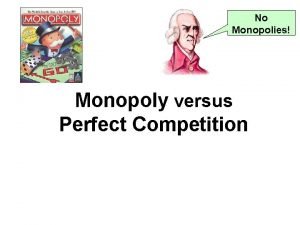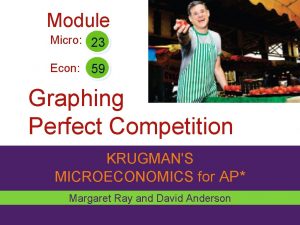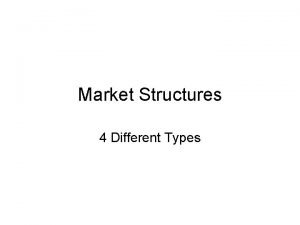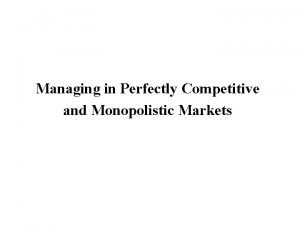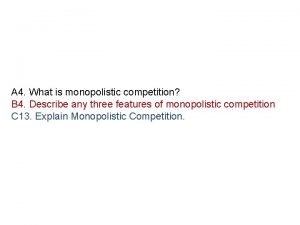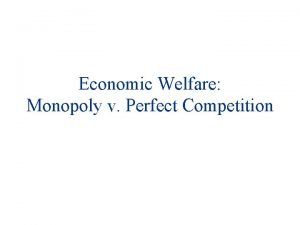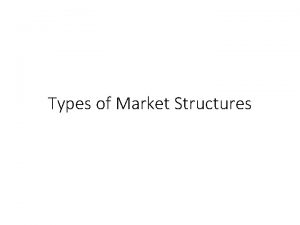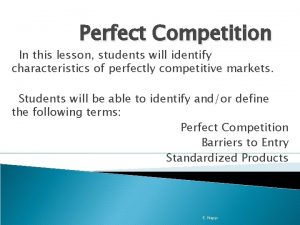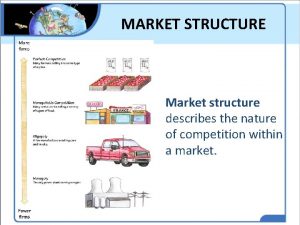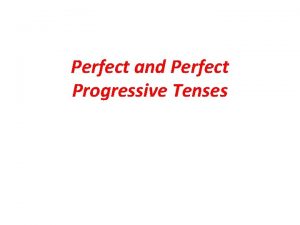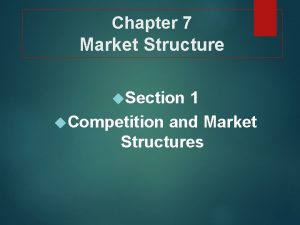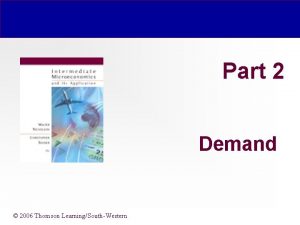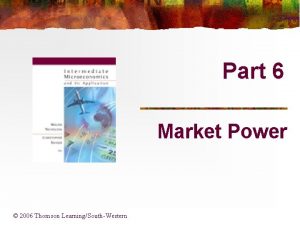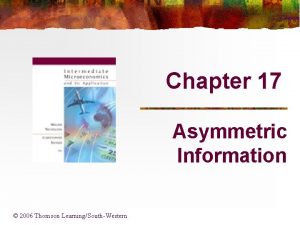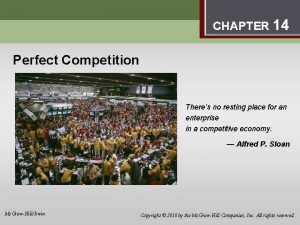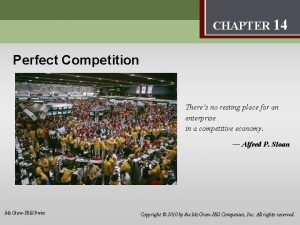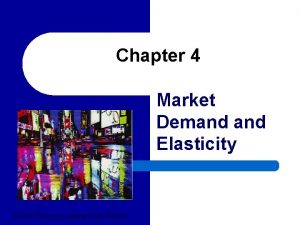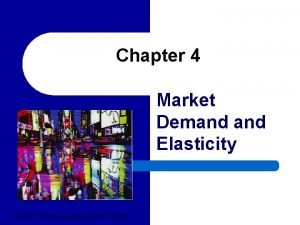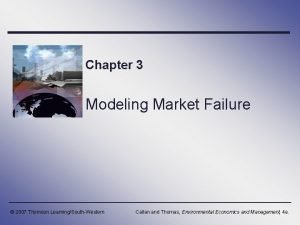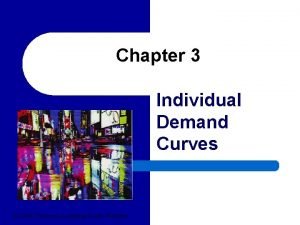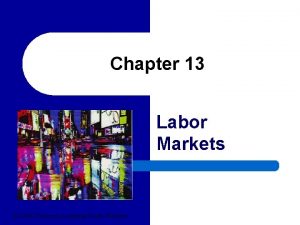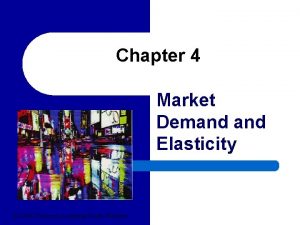Part 5 Perfect Competition 2006 Thomson LearningSouthWestern Chapter
























































- Slides: 56

Part 5 Perfect Competition © 2006 Thomson Learning/South-Western

Chapter 10 Perfect Competition in a Single Market © 2006 Thomson Learning/South-Western

Pricing in the Very Short Run n 3 The market period (very short run) is a short period of time during which quantity supplied is fixed. In this period, price acts to ration demand as it adjusts to clear the market. This situation is illustrated in Figure 10 -1 where supply is fixed at Q*.

FIGURE 10 -1: Pricing in the Very Short Run Price S P 1 D 0 4 Q* Quantity per week

Pricing in the Very Short Run n n 5 When demand is represented by the curve D, P 1 is the equilibrium price. The equilibrium price is the price at which the quantity demanded by buyers of a good is equal to the quantity supplied by sellers of the good.

Shifts in Demand: Price as a Rationing Device n n 6 If demand were to increase, as illustrated by the new demand curve D’ in Figure 10 -1, P 1 is no longer the equilibrium price since the quantity demanded exceeds the quantity supplied. The new equilibrium price is now P 2 where price has rationed the good to those who value it the most.

FIGURE 10 -1: Pricing in the Very Short Run Price S P 2 P 1 D’ D 0 7 Q* Quantity per week

Construction of a Short-Run Supply Curve n n n 8 The quantity that is supplied is the sum of the quantities supplied by each firm. The short-run market supply curve is the relationship between market price and quantity supplied of a good in the short run. In Figure 10 -2 it is assumed that there are only two firms, A and B.

FIGURE 10 -2: Short-Run Market Supply Curve Price SA P 0 q A 1 (a) Firm A 9 Output 0 Output (b) Firm B 0 Quantity per week (c) The Market

FIGURE 10 -2: Short-Run Market Supply Curve Price SB SA P 0 q A 1 (a) Firm A 10 Output 0 q B 1 Output 0 (b) Firm B Quantity per week (c) The Market

FIGURE 10 -2: Short-Run Market Supply Curve Price SB SA S P 0 q A 1 (a) Firm A 11 Output 0 q B 1 Output 0 (b) Firm B Q 1 Quantity per week (c) The Market

Construction of a Short-Run Supply Curve n n Both firm A’s and firm B’s short-run supply curves (their marginal cost curves) are shown in Figure 10 -2(a) and Figure 10 -2(b) respectively. The market supply curve is the horizontal sum of the two firms at every price. n 12 In Figure 10 -2(c), Q 1 equals the sum of q 1 A and q 1 B.

Short-Run Price Determination n n 13 Figure 10 -3 (b) shows the market equilibrium where the market demand curve D and the short-run supply curve S intersect at a price of P 1 and quantity Q 1. This equilibrium would persist since what firms supply at P 1 is exactly what people want to buy at that price.

FIGURE 10 -3: Interaction of Many Individuals and Firms Determine market price in the Short Run Price SMC Price SAC P 1 D 0 q 1 q 2 Output (a) Typical Firm 14 0 Q 1 Q 2 Quantity per week (b) The Market d 0 q 1 q 2 q‘ 1 Quantity (c) Typical Person

FIGURE 10 -3: Interaction of Many Individuals and Firms Determine market price in the Short Run Price SMC Price SAC P 2 D’ P 1 d’ D 0 q 1 q 2 Output (a) Typical Firm 15 0 Q 1 Q 2 Quantity per week (b) The Market d 0 q 1 q 2 q‘ 1 Quantity (c) Typical Person

Functions of the Equilibrium Price n The price serves as a signal to producers about how much should be produced. n n 16 To maximize profit, firms will produce the output level for which marginal costs equal P 1. This yields an aggregate production of Q 1.

Functions of the Equilibrium Price n Given the price, utility maximizing individuals will decide how much of their limited incomes to spend n n n 17 At price P 1 the total quantity demanded is Q 1. No other price brings about the balance of quantity demanded and quantity supplied. These situations are depicted in Figure 10 -3 (a) and (b) for the typical firm and individual, respectively.

Effect of an Increase in Market Demand n n 18 If the typical person’s demand for the good increases from d to d’, the entire market demand curve will shift to D’ as shown in figure 10 -3. The new equilibrium is P 2, Q 2 where a new balance between demand supply is established.

Effect of an Increase in Market Demand n n n 19 The increase in demand resulted in a higher equilibrium price, P 2 and a greater equilibrium quantity, Q 2. P 2 has rationed the typical person’s demand so that only q 2 is demanded rather than the q’ 1 that would have been demanded at P 1. P 2 also signals the typical firm to increase production from q 1 to q 2.

Shifts in Demand Curves n Demand will increase, shift outward, because n n 20 Income increases The price of a substitute rises The price of a complement falls Preferences for the good increase

Shifts in Demand Curves n Demand will decrease, shift inward, because n n 21 Income falls The price of a substitute falls The price of a complement rises Preferences for the good diminish

Shifts in Supply Curves n Supply will increase, shift outward, because n n n Supply will decrease, shift inward, because n 22 Input prices fall Technology improves Input prices rise

Table 10 -1: Reasons for a Shift in a Demand or Supply Curve 23

Short-Run Supply Elasticity n 24 The short-run elasticity of supply is the percentage change in quantity supplied in the short run in response to a 1 percent change in price.

Shifts in Supply Curves and the Importance of the Shape of the Demand Curve n The effect of a shift in supply upon equilibrium levels of P and Q depends upon the shape of the demand curve. n n 25 If demand is elastic, as in Figure 10 -4 (a), a decrease in supply has a small effect on price but a relatively large effect on quantity. If demand is inelastic, as in Figure 10 -4 (b), the decrease in supply has a greater effect on price than on quantity.

FIGURE 10 -4: Effect of a Shift in the Short-Run Supply Curve on the Shape of the Demand Curve Price S P Price D S P D 0 Q Quantity per week (a) Elastic Demand 26 0 Q Quantity per week (b) Inelastic Demand

FIGURE 10 -4: Effect of a Shift in the Short-Run Supply Curve on the Shape of the Demand Curve S’ Price S’ S P’ P’ P D 0 Q’ Q Quantity per week (a) Elastic Demand 27 0 Q’ Q Quantity per week (b) Inelastic Demand

Shifts in Demand Curves and the Importance of the Shape of the Supply Curve n The effect of a shift in demand upon equilibrium levels of P and Q depends upon the shape of the supply curve. n n 28 If supply is inelastic, as in Figure 10 -5 (a), the effect on price is much greater than on quantity. If the supply curve is elastic, as in Figure 10 -5 (b), the effect on price is relatively smaller than the effect on quantity.

Figure 10 -5: Effect of A shift in the Demand Curve Depends on the Shape of the Short-Run Supply Curve S Price S P’ P P D 0 Q Quantity 0 per week (a) Inelastic Supply 29 D Q Quantity per week (b) Elastic Supply

Figure 10 -5: Effect of A shift in the Demand Curve Depends on the Shape of the Short-Run Supply Curve S Price S P’ P D’ D 0 Q Q’ Quantity 0 per week (a) Inelastic Supply 30 D Q Q’ Quantity per week (b) Elastic Supply

FIGURE 10 -6: Demand Supply Curves for CDs Price S 10 6 2 0 31 4 D 10 CDs per week

FIGURE 10 -6: Demand Supply Curves for CDs Price $12 S 10 7 6 5 2 0 32 3456 D D’ 10 12 CDs per week

TABLE 10 -2: Supply and Demand Equilibrium in the Market for CDs 33 New equilibrium Initial equilibrium

Profit Maximization n It is assumed that the goal of each firm is to maximize profits. n n 34 Since each firm is a price taker, this implies that each firm produce where price equals long-run marginal cost. This equilibrium condition, P = MC determines the firm’s output choice and its choice of inputs that minimize their long-run costs.

Entry and Exit n Entry will cause the short-run market supply curve to shift outward causing the market price to fall. n n 35 This will continue until positive economic profits are no longer available. Exit causes the short-run market supply curve to shift inward causing the market price to increase, eliminating the economic losses.

Long-Run Equilibrium n n n 36 P = MC results from the assumption that firm’s are profit maximizers. P = AC results because market forces cause long run economic profits to equal zero. In the long run, firm owners will only earn normal returns on their investments.

Long-Run Supply: The Constant Cost Case n n n 37 The constant cost case is a market in which entry or exit has no effect on the cost curves of firms. Figure 10 -7 demonstrates long-run equilibrium for the constant cost case. Figure 10 -7 (b) shows that market where the market demand supply curves are D and S, respectively, and equilibrium price is P 1.

FIGURE 10 -7: Long-Run Equilibrium for a Perfectly Competitive Market: Constant Cost Case Price SMC MC S AC P 1 D 0 q 1 (a) Typical Firm 38 Output 0 Q 1 (b) Total Market Quantity per week

FIGURE 10 -7: Long-Run Equilibrium for a Perfectly Competitive Market: Constant Cost Case Price SMC MC S AC P 2 P 1 D D 0 q 1 q 2 (a) Typical Firm 39 Output 0 Q 1 Q 2 (b) Total Market Quantity per week

FIGURE 10 -7: Long-Run Equilibrium for a Perfectly Competitive Market: Constant Cost Case Price SMC MC S AC S’ P 2 LS P 1 D D 0 q 1 q 2 (a) Typical Firm 40 Output 0 Q 1 Q 2 Q 3 (b) Total Market Quantity per week

Long-Run Supply: The Constant Cost Case n n 41 The typical firm will produce output level q 1 which results in Q 1 in the market. The typical firm is maximizing profits since price is equal to long-run marginal cost. The typical firm is earning zero economic profits since price equals long-run average total costs. There is no incentive for exit or entry.

A Shift in Demand n n n 42 If demand increases to D’, the short-run price will increase to P 2. A typical firm will maximize profits by producing q 2 which will result in short-run economic profits (P 2 > AC). Positive economic profits cause new firms to enter the market until economic profits again equal zero.

A Shift in Demand n n n 43 Since costs do not increase with entry, the typical firm’s costs curves do not change. The supply curve shifts to S’ where the equilibrium price returns to P 1 and the typical firm produces q 1 again. The new long-run equilibrium output will be Q 3 with more firms in the market.

Long-Run Supply Curve n n n 44 Regardless of the shift in demand, market forces will cause the equilibrium price to return to P 1 in the long-run. The long-run supply curve is horizontal at the low point of the firms long-run average total cost curves. This long-run supply curve is labeled LS in Figure 10 -7 (b).

FIGURE 10 -8: Increasing Costs Result in a Positively Sloped Long-Run Supply Curve Price SMC MC SMC P 2 AC P 3 P 1 0 P 1 q 2 Output (a) Typical Firm before (b) Entry 45 D AC MC S 0 q 3 Output (b) Typical Firm after Entry 0 2 Q 1 (c) The Market Quantity per week

FIGURE 10 -8: Increasing Costs Result in a Positively Sloped Long-Run Supply Curve Price SMC MC P 2 SMC MC q 1 q 2 Output 0 S D P 1 (a) Typical Firm before Entry 46 AC D’ P 2 AC P 1 0 Price q 3 Output 0 (b) Typical Firm after Entry 2 Q 1 Q 2 Q 3 (c) The Market Quantity per week

FIGURE 10 -8: Increasing Costs Result in a Positively Sloped Long-Run Supply Curve Price SMC MC P 2 AC Price SMC MC D AC P 3 q 2 Output 0 (a) Typical Firm before Entry 47 S’ LS P 3 P 1 q 1 S P 2 P 1 0 D’ q 3 Output 0 (b) Typical Firm after Entry 2 Q 1 Q 2 Q 3 (c) The Market Quantity per week

The Increasing Cost Case n n 48 This case is shown in Figure 10 -8, where the initial equilibrium price is P 1 with the typical firm producing q 1 with total output Q 1. Economic profits are zero. The increase in demand to D’, with shortrun supply curve S, causes equilibrium price to increase to P 2 with the typical firm producing q 2 resulting in positive profits.

The Increasing Cost Case n n 49 The positive profits entice firms to enter which drives up costs. The typical firm’s new cost curves are shown in Figure 10 -8 (b). The new long-run equilibrium price is P 3 with market output Q 3. The long-run supply curve, LS, is positively sloped because of the increasing costs.

Long-Run Supply Elasticity n 50 The long-run elasticity of supply is the percentage change in quantity supplied in the long run in response to a 1 percent change in price.

TABLE 10 -3: Estimated Long-Run Supply Elasticities 51

The Decreasing Cost Case n n n 52 The initial equilibrium is shown as P 1, Q 1 in Figure 10 -9 (c). The increase in demand from D to D’ results in the short-run equilibrium, P 2, Q 2 where the typical firm is earning positive economic profits. Entry drives down costs for the typical firm, as shown in Figure 10 -9 (b).

FIGURE 10 -9: Decreasing Costs Result in a Negatively Sloped Long-Run Supply Curve Price SMC D MC P 2 AC P 1 0 Output 0 (a) Typical Firm before Entry 53 SMC MC AC q 1 S Price P 1 Output 0 (b) Typical Firm after Entry 2 Q 1 (c) The Market Quantity per week

FIGURE 10 -9: Decreasing Costs Result in a Negatively Sloped Long-Run Supply Curve Price SMC D MC P 2 AC P 1 0 P 2 SMC MC AC q 1 q 2 Output 0 P 1 Output 0 (a) Typical Firm before Entry (b) Typical Firm after Entry 54 S D’ 2 Q 1 Q 2 (c) The Market Quantity per week

FIGURE 10 -9: Decreasing Costs Result in a Negatively Sloped Long-Run Supply Curve Price SMC D MC P 2 AC SMC P 1 q 2 Output 0 (a) Typical Firm before Entry 55 S’ MC AC P 3 0 S D’ P 1 2 P 3 q 3 Output 0 (b) Typical Firm after Entry LS Q 1 Q 2 (c) The Market Q 3 Quantity per week

The Decreasing Cost Case n n n 56 Entry continues until short-run economic profits are eliminated. The new long-run equilibrium is P 3, Q 3 as shown in Figure 10 -9 (c). The long-run supply curve is downward sloping due to the decreasing costs as labeled LS in Figure 10 -9 (c).
 Lump sum subsidy
Lump sum subsidy Perfect competition vs monopolistic competition
Perfect competition vs monopolistic competition Perfect competition vs monopolistic competition
Perfect competition vs monopolistic competition Market structure venn diagram
Market structure venn diagram Chapter 7 section 1 perfect competition worksheet answers
Chapter 7 section 1 perfect competition worksheet answers Past perfect present perfect future perfect
Past perfect present perfect future perfect Vandal sport
Vandal sport Perfect competition side by side graphs
Perfect competition side by side graphs Long run market supply curve
Long run market supply curve Short term equilibrium
Short term equilibrium Shutdown point
Shutdown point Monopoly conditions
Monopoly conditions Long run supply curve
Long run supply curve Perfect competition disadvantages
Perfect competition disadvantages Perfect competition 4 conditions
Perfect competition 4 conditions Shut down point
Shut down point Why is starbucks monopolistic competition
Why is starbucks monopolistic competition Difference between perfect competition and monopoly market
Difference between perfect competition and monopoly market Public goods
Public goods Barriers to entry for perfect competition
Barriers to entry for perfect competition Profit maximization
Profit maximization Factor market perfect competition
Factor market perfect competition Pricing and output decisions in perfect competition
Pricing and output decisions in perfect competition Barriers to entry for perfect competition
Barriers to entry for perfect competition Difference perfect competition and monopoly
Difference perfect competition and monopoly Long run market supply curve
Long run market supply curve Difference between perfect competition and monopoly market
Difference between perfect competition and monopoly market Three characteristics of perfect competition
Three characteristics of perfect competition Price determination under perfect competition
Price determination under perfect competition Short run equilibrium under perfect competition
Short run equilibrium under perfect competition Supernormal profit in perfect competition
Supernormal profit in perfect competition Mr mc graph
Mr mc graph Graphing perfect competition
Graphing perfect competition Difference between perfect competition and monopoly
Difference between perfect competition and monopoly Perfect competion examples
Perfect competion examples Consumer surplus in perfect competition
Consumer surplus in perfect competition Supernormal profit in perfect competition
Supernormal profit in perfect competition Perfect competition poster
Perfect competition poster Perfect competition quiz
Perfect competition quiz Monopoly deadweight loss
Monopoly deadweight loss The opposite of perfect competition is
The opposite of perfect competition is List the four conditions for perfect competition.
List the four conditions for perfect competition. One seller complete barriers to market entry
One seller complete barriers to market entry Pros and cons of monopolistic competition
Pros and cons of monopolistic competition Perfect pitch challenge
Perfect pitch challenge Disadvantages of perfect competition
Disadvantages of perfect competition Disadvantages of perfect competition
Disadvantages of perfect competition Perfect and perfect progressive tenses
Perfect and perfect progressive tenses Chapter 3 perfect and perfect progressive tenses
Chapter 3 perfect and perfect progressive tenses Part whole model subtraction
Part whole model subtraction Part to part ratio definition
Part to part ratio definition Part part whole
Part part whole Technical object description example
Technical object description example Parts of a bar club
Parts of a bar club The part of a shadow surrounding the darkest part
The part of a shadow surrounding the darkest part 미니탭 gage r&r 해석
미니탭 gage r&r 해석 Monopolistic competition examples
Monopolistic competition examples









